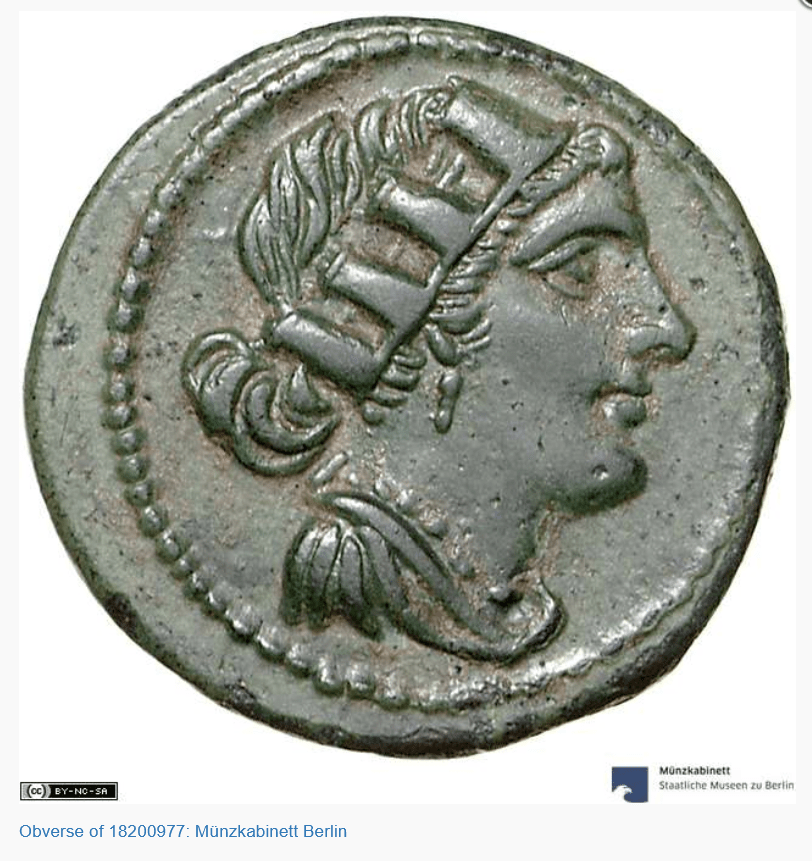Feronia appears on eight coins types struck at Rome by IIIvirs after 19 BCE and before 4 CE during the short lived republican coin type revival of moneyers signing coins. These coins also commonly revive early types on which I’ve blogged before. (Hercules example, Sicily example)
So I was looking at this coin and a bell went off in my head.

These representations of Feronia (identifed with FE or FER or FERO as a legend), remind me strongly of RRC 39/5, a type with a mysterious obverse (early blog post). I strongly suspect that Turpilianus’ Feronia is modeled on this early coin type. That doesn’t mean that the earlier coin type was intended to represent Feronia but that has to be considered. A Roman at the end of the first century BCE has a much richer visual knowledge base to use to identify historical iconography, not to mention a basic cultural framework.

Livy 26.11 (cf. Sil. Ital. Pun. 13.83ff.) recounts that Hannibal sacked the wealthy sanctuary of Feronia. At about the same time this coin was struck.
The city of Feronia is at the foot of Mount Soracte, with the same name as a certain native goddess, a goddess greatly honoured by the surrounding peoples; her sacred precinct is in the place; and it has remarkable ceremonies, for those who are possessed by this goddess walk with bare feet through a great heap of embers and ashes without suffering and a multitude of people come together at the same time, for the sake not only of attending the festal assembly, which is held here every year, but also of seeing the aforesaid sight.
Strabo 5.2.9
There is also another account given of the Sabines in the native histories, to the effect that a colony of Lacedaemonians settled among them at the time when Lycurgus, being guardian to his nephew Eunomus, gave his laws to Sparta. For the story goes that some of the Spartans, disliking the severity of his laws and separating from the rest, quitted the city entirely, and after being borne through a vast stretch of sea, made a vow to the gods to settle in the first land they should reach; for a longing came upon them for any land whatsoever. At last they made that part of Italy which lies near the Pomentine plains and they called the place where they first landed Foronia, in memory of their being borne through the sea, and built a temple owing to the goddess Foronia, to whom they had addressed their vows; this goddess, by the alteration of one letter, they now call Feronia. And some of them, setting out from thence, settled among the Sabines. It is for this reason, they say, that many of the habits of the Sabines are Spartan, particularly their fondness for war and their frugality and a severity in all the actions of their lives. But this is enough about the Sabine race.
Dionysius RA 2.49.4-5
After this war another arose against the Romans on the part of the Sabine nation, the beginning and occasion of which was this. There is a sanctuary, honoured in common by the Sabines and the Latins, that is held in the greatest reverence and is dedicated to a goddess named Feronia; some of those who translate the name into Greek call her Anthophoros or “Flower Bearer,” others Philostephanos or “Lover of Garlands,” and still others Persephonê. To this sanctuary people used to resort from the neighbouring cities on the appointed days of festival, many of them performing vows and offering sacrifice to the goddess and many with the purpose of trafficking during the festive gathering as merchants, artisans and husbandmen; and here were held fairs more celebrated than in any other places in Italy.
Dionysius RA 3.32.1 (cf. Livy 1.30)
In Italy in the time of the Caesarian war people ceased to build towers between Terracina and the Temple of Feronia, as every tower there was destroyed by lightning.
Pliny NH 2.56
Di Fazio, Massimiliano. “Feronia: the role of an Italic goddess in the process of cultural integration in republican Italy.” In Processes of integration and identity formation in the Roman Republic, Edited by Roselaar, Saskia Tessa. Mnemosyne. Supplements; 342, 337-354. Leiden ; Boston (Mass.): Brill, 2012. Abstract: The cult of Feronia was introduced in Rome from Sabine territory in the 4th or 3rd cent. B.C. Worship of the goddess was then carried throughout Italy, following the routes of Roman expansion. Religious Romanization was sometimes a matter of three levels : there were the Romans, the Romanized, and the locals. There has been an underestimation of the contribution of indigenous cultures to the formation of Roman culture.
Di Fazio, Massimiliano. Feronia: spazi e tempi di una dea dell’Italia centrale antica. Roma: Quasar, 2013.
Lots more earlier bibliography on APh, mostly in Italian.
Update 1-20-23:

[…] she avoids using that term). This article will be good to circle back on when I return to either Feronia (last chapter of current book project) and/or Ino-Leukothea (esp. RRC 399/1, n.b. my glass paste […]